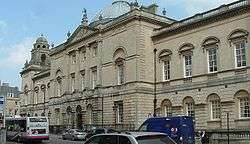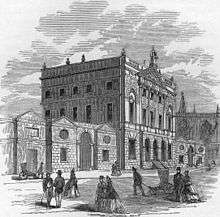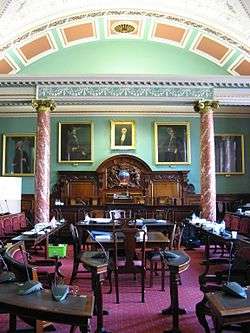Guildhall, Bath
| The Guildhall | |
|---|---|
 | |
| Location | Bath, Somerset, England |
| Coordinates | 51°22′55″N 2°21′32″W / 51.38194°N 2.35889°WCoordinates: 51°22′55″N 2°21′32″W / 51.38194°N 2.35889°W |
| Built | 1775 |
| Architect | Thomas Baldwin |
Listed Building – Grade I | |
| Designated | 12 June, 1950[1] |
| Reference no. | 442118 |
 Location of The Guildhall in Somerset | |
The Guildhall in Bath, Somerset, England was built between 1775 and 1778 by Thomas Baldwin to designs by Thomas Warr Attwood. It was extended by John McKean Brydon in 1893. It has been designated as a Grade I listed building.[1][2]
The current Bath stone building replaced a Stuart Guildhall, built in 1625, which itself replaced an earlier Tudor structure.[3]
The central facade has 4 Ionic columns and the building is surmounted by the figure of Justice. The central dome and the north and south wings were added in 1893.[1][2] It forms a continuous building with the Victoria Art Gallery and the covered market.
The interior includes a banqueting hall with engaged Corinthian columns. It contains 18th century chandeliers and original royal portraits. The room is used on royal visits to the city including Queen Elizabeth II who had lunch in the banqueting room in May 2002.[4]
It now houses the Bath and North East Somerset Council chamber, the Register office for Bath and North East Somerset, which sees the building used as a wedding venue, and houses the Bath and North East Somerset Archives and Local Studies services in the Bath Record Office.[5][6][7] The Guildhall also serves as one of the venues for the Bath International Music Festival and other cultural events. It has been used for filming period dramas.[8]
The Guildhall was originally built as a town hall: it has never served as the meeting place of any specific guild. A suggested etymology is from the Anglo Saxon "gild", or "payment"; the guildhall being where citizens came to pay their rates.
Bath Guildhall Market
Bath Guildhall Market is located behind the Guildhall, and can be accessed by its own entrance tunnel through the Guildhall. It has traded on its site for the last 800 years. About 20 stall holders trade there nowadays.[9]
Gallery
 The Guildhall in 1864 before the extensions were built
The Guildhall in 1864 before the extensions were built The Guildhall circa 1895
The Guildhall circa 1895 Council Chamber
Council Chamber Alkmaar Room
Alkmaar Room- Neoclassic frieze (John Brydon, architect)
See also
References
- 1 2 3 "Guildhall". Images of England. English Heritage. Retrieved 2009-07-25.
- 1 2 "Guildhall, Bath and North East Somerset". The National Heritage List for England. Historic England. Retrieved 2017-12-07.
- ↑ Fawcett, Trevor. "The Stuart Guildhall". Bath Past. Retrieved 2009-07-25.
- ↑ "Banqueting room". Bath's Historic Buildings. Bath and North East Somerset Council. Retrieved 2009-07-25.
- ↑ "The Guildhall in Bath". Bath's Historic Buildings. Bath and North East Somerset Council. Retrieved 2009-07-25.
- ↑ "Marriages in the Guildhall". Bath's Historic Buildings. Bath and North East Somerset Council. Archived from the original on 2010-10-19. Retrieved 2010-10-15.
- ↑ "Getting Here: Bath Record Office". Bath Archives and Local Studies. Bath and North East Somerset Council. Retrieved 2017-12-07.
- ↑ "Council Chamber". Bath's Historic Buildings. Bath and North East Somerset Council. Retrieved 2009-07-25.
- ↑ "Guildhall Market". visitBath. Retrieved 13 November 2015.